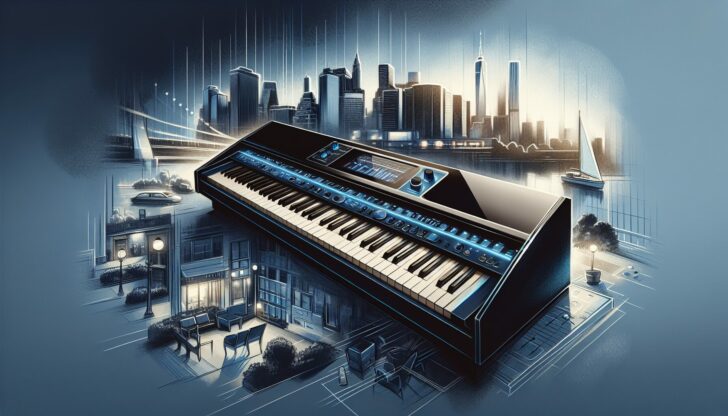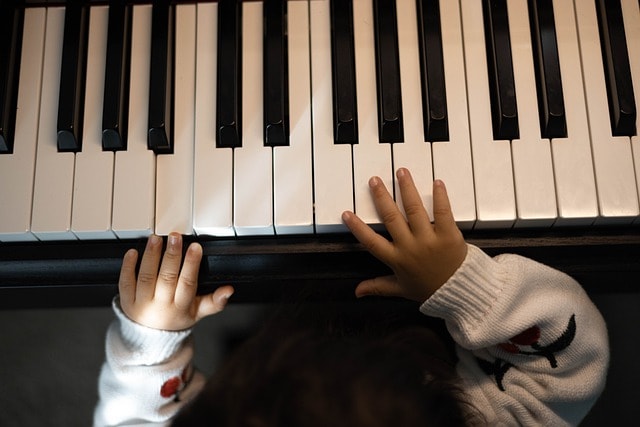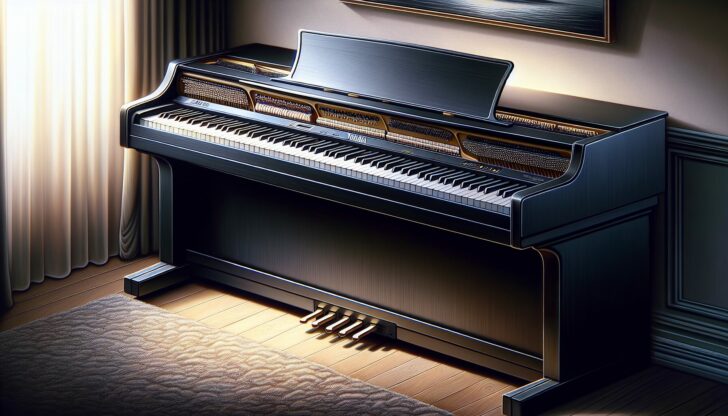Searching for the best piano electric options in 2024? This article helps you find the right electric piano for any skill level and budget. We’ll cover crucial features, from beginners’ essentials to professional needs.
Table of Contents
Key Takeaways
Electric pianos offer a convenient and versatile alternative to acoustic pianos, with features like silent practice options and portability, making them suitable for a wide audience from beginners to professionals.
Key features to consider when selecting an electric piano include weighted keys for an authentic playing experience, high-quality sound engines, sufficient polyphony, and modern connectivity options for enhanced versatility.
Several top picks for various budgets and skill levels are highlighted, including the Yamaha PSR-E373 for beginners under $300, the Roland FP-10 for beginner to intermediate players under $500, and the Kawai ES110 for intermediate players under $1,000, each providing specific features that cater to their respective user needs.
Understanding Electric Pianos

An electric piano, an electronic keyboard instrument, is engineered to mimic an acoustic piano’s sound and feel. Electric pianos, contrasting acoustic ones, produce sound with electronic speakers which play back superior recordings from acoustic pianos. This technology eliminates the need for regular tuning and maintenance, making electric pianos a convenient choice for many.
Portability is a distinguishing feature of electric pianos. They can be easily moved and transported, which is a significant advantage over the heavier and bulkier acoustic pianos. For those living in shared spaces or apartments, the ability to practice silently using headphones without disturbing others is a game-changer. This makes electric pianos suitable for both aspiring students and professional musicians who need to practice at odd hours.
A wide audience from young novices to experienced professionals can benefit from electric pianos. Their versatility and range of features make them ideal for students learning to play, while their high-quality sound and feel can satisfy even the most discerning pianist. Whether you’re a beginner looking for an entry-level instrument or a professional needing a reliable piano for performances, electric pianos offer a practical and appealing solution.
Key Features to Look For

Selecting an electric piano involves considering several key features that can markedly improve your playing experience. One of the most important aspects is the presence of weighted keys. These keys simulate the touch and feel of an acoustic piano’s hammers, providing a more authentic playing experience. Fully-weighted keys and graded action are particularly desirable as they add resistance to each key, with heavier resistance on lower keys, closely mimicking an acoustic piano.
Another pivotal element is sound quality. High-quality digital pianos use layers of recordings and digital modeling to recreate the tone of an acoustic piano. Polyphony, the number of notes that can be played simultaneously, is also important. For beginners, 64 notes of polyphony are usually sufficient, but more advanced players might need 128 or even 192 notes to avoid cutting off sustained sounds during complex pieces.
Connectivity options enhance the versatility of electric pianos. Modern digital pianos often include:
a headphone jack
a USB MIDI port
L/R line outs
a sustain pedal input
Bluetooth connectivity for wireless MIDI and audio functionality
Additional features like built-in metronomes, recording functions, and practice modes can aid in both learning and performance.
Best Budget Electric Piano Under $300
Those on a tight budget may face difficulty, but it’s not impossible to find a quality electric piano under $300. The Yamaha PSR-E373 stands out as a top pick in this category, offering a great balance of features and affordability. With 622 instrument voices and 205 auto-accompaniment styles, it provides a wide range of sounds that can keep beginners engaged and motivated.
The PSR-E373 includes the following features:
Super Articulation Lite, which enhances expressiveness by adding nuanced details to the sound
Built-in USB audio interface for easy audio data transmission
Versatile option for connecting to computers and other devices
While it may not match the realism of higher-end models, it offers excellent value for its price point.
In addition to the Yamaha PSR-E373, other budget-friendly options include the Alesis Recital Pro and the Casio CT-S300. The Alesis Recital Pro features 12 voices and 128 notes of polyphony, making it a strong contender in this price range. The Casio CT-S300, known for its compact and lightweight design, includes features like dance music mode and USB-MIDI connectivity, making it a versatile and portable choice.
Top Pick: Yamaha PSR-E373
For buyers on a budget, the Yamaha PSR-E373 is an excellent choice. With 622 instrument voices and 205 auto-accompaniment styles, it offers a wide variety of sounds that can cater to different musical preferences and styles. The Super Articulation Lite feature enhances the expressiveness of the instrument, making it feel more dynamic and responsive.
Additionally, the PSR-E373 keyboard has the following features:
61 keys
Touch-sensitive keys for expressive playing
622 high-quality instrument voices
205 accompaniment styles
Lesson function with Yamaha Education Suite (Y.E.S.)
Built-in USB audio interface for easy audio data transmission
These features make the PSR-E373 a versatile and valuable addition to any beginner’s musical journey.
In Use
The Yamaha PSR-E373 proves to be an instrument that is easy to use in practice. Its features include:
Light and easy to play keyboard action, making it ideal for beginners
Varied electric piano sounds that are relatively authentic
A good range of options for different styles of music
The PSR-E373 has the following features:
Responsive velocity sensitivity, with four customizable levels
Adaptability to different playing techniques and dynamics
Practical choice for beginners who are still developing their playing style and technique.
Alternatives
The Casio CT-S300 and Yamaha PSR-E273 are superb alternatives for those looking for options other than the Yamaha PSR-E373. The Casio CT-S300 is known for its compact and lightweight design, making it highly portable. It also includes a dance music mode, allowing users to create and remix electronic dance music quickly.
The Yamaha PSR-E273 is another viable alternative, offering a variety of instrument sounds, including other sounds, and user-friendly features. While these cheaper digital keyboards may lack the high-quality acoustic piano tones found in more expensive models, they provide a fun and engaging way for beginners to explore different sounds and styles.
Check out Best Digital Piano under $300.
Best Beginner Electric Piano Under $500
The Roland FP-10 stands out as a leading contender in the category of beginner electric pianos under $500. Known for its:
high-quality sound
key action
fully weighted hammer action keys
SuperNATURAL Piano Sound engine
The FP-10 is an excellent choice for beginners who want a substantial instrument to start their musical journey. It sets itself apart from other options in this price range.
The FP-10’s SuperNATURAL piano sound engine offers 15 instrument sounds, delivering rich and authentic piano tones that can inspire and motivate beginners. Its 88 fully weighted keys, using the PHA-4 Standard keyboard with escapement and ivory feel, provide a realistic playing experience that closely mimics an acoustic piano. This combination of features makes the FP-10 a highly valued instrument for beginners, and its piano tones have sounded impressive to many.
In addition to the Roland FP-10, other noteworthy options include the Yamaha P-45 and Roland GO:Keys. The Yamaha P-45 features Graded Hammer Standard (GHS) keys and AWM stereo sampling technology, offering a slightly lighter action compared to Roland’s PHA-4 Standard. The Roland GO:Keys, on the other hand, is designed for ease of use and portability, making it another excellent alternative for beginners.
Top Pick: Roland FP-10
Owing to its features, the Roland FP-10 is an exceptional choice for beginners:
Fully weighted hammer action keys
SuperNATURAL Piano Sound engine
Professional-grade sound and feel
15 instrument sounds for a rich and authentic piano tone
This combination, including the harpsichord, makes it an ideal instrument for those new to playing the piano, and can inspire budding musicians.
With its 88 fully weighted keys using the PHA-4 Standard keyboard with escapement and ivory feel, the FP-10 delivers a real piano playing experience that closely mimics an acoustic piano. This feature is particularly valuable for beginners, as it helps develop proper finger strength and technique from the start.
Playing Experience
With its PHA-4 Standard keyboard that includes an escapement mechanism and synthetic ivory key surfaces, the Roland FP-10 offers a lifelike playing experience. These features provide a tactile response similar to that of an acoustic piano, enhancing the overall playing experience. The keyboard’s light action and responsive velocity sensitivity can be adjusted to four different levels, allowing players to customize their touch response.
Additionally, key off resonance and sympathetic string resonance features enhance the realism of the sound, mimicking the subtle nuances of an acoustic piano. These features make practicing on the FP-10 a rewarding experience, helping beginners build their skills with a high-quality instrument.
Alternatives
The Yamaha P-45 and Roland GO:Keys are commendable alternatives for those seeking options other than the Roland FP-10.
The Yamaha P-45 features:
Graded Hammer Standard (GHS) keys
AWM stereo sampling technology
Slightly lighter action compared to the Roland PHA-4 Standard
64-note polyphony
10 built-in sounds
This makes it a versatile option for beginners.
The Roland GO:Keys offers a range of fun and engaging features that make it an excellent alternative for beginners. Some of its key features include:
User-friendly interface
Compact design
Portability
Versatility
These features make it a practical choice for those who need a portable and versatile instrument.
Learn more, check out Best Beginner Digital Pianos Under $500.
Best Intermediate Electric Piano Under $1,000
The requirement for a more sophisticated instrument becomes apparent as players progress in their piano journey. The Kawai ES110 is a prominent choice under $1,000 for intermediate players. Known for its robust sound engine, excellent key action, and touch sensitivity, the ES110 is designed to meet the needs of advancing pianists.
The Kawai ES110 features:
Responsive Hammer Compact (RHC) action, which provides a realistic piano feel with a dual sensor mechanism that enhances authenticity and responsiveness
Harmonic Imaging sound engine, which includes samples from Kawai’s EX concert grand piano
A rich and varied sound palette that includes 19 different instrument sounds, including 8 pianos and 3 electric pianos
Alternatives such as the Roland FP-30X and Korg B2 also offer compelling features in the sub-$1,000 range. The Roland FP-30X uses the PHA-4 Standard action with triple sensor and escapement, providing a versatile playing experience suitable for various styles.
The Korg B2, with its Natural Weighted Hammer Action keys and 120-note polyphony, is another excellent option for intermediate players.
Top Pick: Kawai ES110
Intermediate players favor the Kawai ES110 because:
Its Responsive Hammer Compact (RHC) action provides a realistic piano feel with a dual sensor mechanism that enhances authenticity and responsiveness.
The Harmonic Imaging sound engine, which includes samples from Kawai’s EX concert grand piano, adds to the richness and variety of sounds.
The ES110 also comes with 88 fully weighted keys with matte black and white keytops, enhancing the overall quality and feel of the instrument.
This electric piano offers a high level of touch sensitivity with multiple settings: Light, Normal, Heavy, and Off, allowing players to customize their playing experience. Additionally, its 192-note polyphony ensures that complex pieces can be played without any notes being cut off.
Performance
The performance of the Kawai ES110 is enhanced by its touch sensitivity settings and 192-note polyphony, which are its key features. The touch sensitivity can be adjusted to Light, Normal, Heavy, or turned off, allowing players to tailor the response to their playing style. This feature is particularly valuable for intermediate players who are refining their technique and dynamics.
The ES110’s 192-note polyphony ensures that even the most complex pieces can be played without any notes being cut off. This high level of polyphony adds depth and realism to the sound, making the playing experience more enjoyable and authentic.
Alternatives
The Roland FP-30X and Korg B2 are excellent alternatives for those considering options other than the Kawai ES110. Here are some features of the Roland FP-30X:
PHA-4 Standard action with triple sensor and escapement, providing a versatile playing experience suitable for various styles
SuperNATURAL sound engine
More powerful speaker system with 22 watts of power, enhancing its sound quality
The Korg B2, with its Natural Weighted Hammer Action keys and 120-note polyphony, is another strong contender in the sub-$1,000 range. Its features include:
Natural Weighted Hammer Action keys
120-note polyphony
High-quality sounds
Advanced features
These qualities make it a suitable option for intermediate players seeking a reliable and versatile instrument.
Check out 5 Best Portable Digital Pianos Under $1000 – REVIEW.
Best Advanced Electric Piano Under $2,000
The Nord Stage 3 is a preferred option under $2,000 for advanced players. It offers:
Extensive sound library
Impressive key action
Robust stage performance capabilities
Advanced Wave Memory 2 sound engine with 128-note polyphony
57 preset tones
These features make it ideal for stage performances and meet the needs of professional musicians.
The Nord Stage 3’s key action is highly responsive and dynamic, catering to professional musicians who need precision in their performances. Its seamless transition feature allows smooth changes between patches without cutting off the previous sound, which is essential for stage musicians.
Alternatives like the Yamaha CP88, Korg Grandstage 88, and Roland RD-2000 also offer professional-grade features. The Yamaha CP88 includes a Natural Wood Graded Hammer Action keyboard, providing a realistic piano feel. The Korg Grandstage 88 is recognized for its high-quality sounds and advanced features, making it another excellent choice for advanced players.
Top Pick: Nord Stage 3
The Nord Stage 3 is renowned for its vast sound library and sophisticated features. With its Advanced Wave Memory 2 sound engine and 128-note polyphony, it offers a rich and diverse range of sounds, including pianos, organs, and synthesizers. This versatility makes it suitable for various musical genres and stage performances.
The Nord Stage 3 offers the following features:
57 preset tones
Seamless transition feature for live performances
Robust key action
Dynamic response
These features make it an ideal instrument for professional musicians who require precision and reliability in their musical instruments.
Professional Use
The key action of the Nord Stage 3 is highly responsive and dynamic, delivering the precision required for professional use. Its seamless transition feature allows smooth changes between patches without cutting off the previous sound, which is essential for live performances. The advanced split and layer capabilities further enhance its suitability for complex live performance setups.
In studio recording settings, the Nord Stage 3’s wide range of sounds and effects enables high-quality and diversified recordings. Its powerful synth section allows for deep sound design, making it suitable for both studio recording and live performances.
Alternatives
The Yamaha CP88 and Korg Grandstage 88 are excellent options for those exploring alternatives to the Nord Stage 3. The Yamaha CP88 features a Natural Wood Graded Hammer Action keyboard, providing a realistic piano feel for advanced players. It is known for its high-quality samples and stage-ready features.
The Korg Grandstage 88, recognized for its high-quality sounds and advanced features, is another excellent choice for advanced players. The Roland RD-2000, with its dual sound engine and powerful layering capabilities, is also a robust alternative to the Nord Stage 3.
Console vs. Portable Electric Pianos
Your specific needs and preferences determine the choice between console and portable electric pianos.
Console pianos often have:
better built-in speakers
offer a more realistic playing experience compared to portable ones
the wood of a console piano’s cabinet can resonate with the speakers, potentially enhancing sound quality.
However, there are some advantages to console pianos:
They are more compact and take up less space in a room
They often have a more stylish and decorative design
They come with lids to cover the keyboard when not in use, protecting the instrument from dust and debris
On the other hand, portable pianos are easier to move around, which can be beneficial if they need service or if you frequently transport your instrument.
Intermediate players might prefer console digital pianos for their more realistic playing experience, while beginners and those who need to move their instrument frequently might opt for portable digital piano options. Ultimately, the choice between console and portable pianos should be based on your lifestyle, playing needs, and personal preferences.
Best Home Electric Piano Under $1,500
The Yamaha YDP-144 is a preferred option under $1,500 for home use. Known for its great value and quality, the YDP-144 features the GH3 action with simulated ivory and ebony key surfaces, offering improved control and moisture absorption. Its 88 fully weighted keys provide an authentic playing experience, closely mimicking that of an acoustic piano.
The Yamaha YDP-144’s furniture-style design includes:
A bench
Headphones
Instructional book
Instructional DVD
This makes it a complete package for home use. Its onboard 20W + 20W speakers provide sufficient power for home settings without needing external amplification. This combination of features makes the YDP-144 an ideal instrument for family enjoyment and home practice.
The Casio PX-870, Kawai CN201, and Korg LP-380U are alternatives that also present compelling features for home use. The Casio PX-870 includes a sleek, modern design with touch sensor controls and an improved internal speaker system.
The Kawai CN201 is known for its realistic stereo piano sound sampling and minimalist control panel design. The Korg LP-380U combines a compact design with a powerful internal speaker system, making it another excellent choice under $1,500.
Top Pick: Yamaha YDP-144

Due to its exceptional value and quality, the Yamaha YDP-144 comes highly recommended for home use. It features the GH3 action with simulated ivory and ebony key surfaces, offering improved control and moisture absorption. Its 88 fully weighted keys provide an authentic playing experience that closely mimics that of an acoustic piano.
The YDP-144’s furniture-style design includes:
a bench
headphones
an instructional book
an instructional DVD
This makes it a complete package for home use. The YDP-144 is an ideal instrument for family enjoyment and home practice.
Home Use
The Yamaha YDP-144 has the following features:
Furniture-style design
Powerful onboard speakers
Cabinet that resembles an acoustic piano
Ability to close the lid
These features make it ideal for home use and aesthetically pleasing for any home setting.
Its onboard 20W + 20W speakers provide sufficient power for home settings without needing external amplification. The sound quality is described as making one want to play more and more, suitable for family enjoyment and regular practice.
Alternatives
The Casio PX-870, Kawai CN201, and Korg LP-380U are excellent alternatives to the Yamaha YDP-144. Here are some key features of each:
Casio PX-870: sleek, modern design, touch sensor controls, improved internal speaker system. However, some users have encountered issues with this model.
Kawai CN201: high-quality sound, realistic keyboard action, built-in lesson features. Users have praised its performance and durability.
Korg LP-380U: compact design, authentic piano sound, multiple instrument sounds. Some users have found the keys to be less responsive compared to other models.
Consider these options when looking for an alternative to the Yamaha YDP-144.
The Kawai CN201 is known for its realistic stereo piano sound sampling and minimalist control panel design. The Korg LP-380U combines a compact design with a powerful internal speaker system, making it a strong contender under $1,500.
Bonus: Best MIDI Keyboards
Choosing the appropriate MIDI keyboard can have a significant impact on your workflow and creativity if you’re involved in digital music production. The Akai Professional MPK Mini MK3 is ideal for beginners and on-the-go producers, featuring 25 mini keys, 8 MPC drum pads, and 8 assignable knobs. Its compact design makes it perfect for mobile music making.
The Novation Launchkey MK3 series offers versions with 25, 37, 49, and 61 keys, designed for intuitive integration with Ableton Live. This makes it a favorite among producers who use Ableton Live for composing, arranging, and performing music. Similarly, the Native Instruments Komplete Kontrol S49 and S61 MK2 offer deep integration with NI’s Komplete software, featuring color-coded lights and touch-sensitive controls.
Other notable MIDI keyboards include the M-Audio Oxygen Pro series, which includes versions with 25, 49, and 61 keys, featuring auto-mapping, and smart chord and scale modes. The Arturia KeyLab MkIII, available in 49 and 61-key versions, is known for its high-quality keybed and comprehensive controls. These MIDI keyboards provide a versatile and powerful toolset for digital music production.
Learn more, visit Best Digital Piano Under $2000
Summary
In summary, choosing the right electric piano depends on your budget, skill level, and specific needs. From the budget-friendly Yamaha PSR-E373 to the professional-grade Nord Stage 3, there are excellent options available for every player. Key features such as weighted keys, sound quality, and connectivity options are crucial in selecting the best instrument for your needs.
By considering the recommendations and alternatives provided in this guide, you can make an informed decision that will enhance your musical journey. Whether you’re a beginner, intermediate player, or professional musician, the right electric piano can make all the difference in your practice and performances. Invest wisely and enjoy the beautiful journey of making music.
Frequently Asked Questions
What are the key features to look for in an electric piano?
When looking for an electric piano, prioritize features like weighted keys, touch sensitivity, sound quality, polyphony, and connectivity options like Bluetooth and USB MIDI. These elements can significantly impact your playing experience.
What is the best budget electric piano under $300?
The best budget electric piano under $300 is the Yamaha PSR-E373, which offers 622 instrument voices, Super Articulation Lite, and a built-in USB audio interface. Choose this one for a great playing experience.
Which electric piano is best for beginners under $500?
The Roland FP-10 is an excellent choice for beginners due to its fully weighted hammer action keys and the SuperNATURAL Piano Sound engine. It is a great option for those looking for an electric piano under $500.
What makes the Kawai ES110 a good choice for intermediate players?
The Kawai ES110 is a good choice for intermediate players because it offers Responsive Hammer Compact action, Harmonic Imaging sound engine, and 88 fully weighted keys, making it ideal for advancing players.
What are the advantages of console electric pianos over portable ones?
Console electric pianos have better built-in speakers and a more realistic playing experience compared to portable ones, but portable pianos are easier to move and service.









